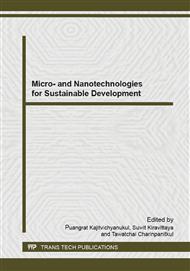[1]
E.T. Kang, K.G. Neoh, K.L. Tan, Polyaniline: a polymer with many interesting intrinsic redox states, Prog. Polym. Sci. 23 (1998) 211-324.
DOI: 10.1016/s0079-6700(97)00030-0
Google Scholar
[2]
P. Ghosh, S.K. Siddhanta, S.R. Haque, A. Chakrabarti, Stable polyaniline dispersions prepared in nonaqeous medium: synthesis and characterization, Synth. Met. 123 (2001) 83-89.
DOI: 10.1016/s0379-6779(00)00579-8
Google Scholar
[3]
J. Stejskal, Polyaniline. Preparation of a conducting polymer, Pure Appl. Chem. 74 (5) (2002) 857-867.
Google Scholar
[4]
Z. Jin, Y. Su, Y. Duan, An improved optical pH sensor based on polyaniline, Sens. Actuators B 71 (2000) 118-122.
DOI: 10.1016/s0925-4005(00)00597-9
Google Scholar
[5]
Z.F. Li, F.D. Blum, M.F. Bertino, C.S. Kim, S.K. Pillalamarri, One-step fabrication of a polyaniline nanofiber vapor sensor, Sens. Actuators B 134 (2008) 31-35.
DOI: 10.1016/j.snb.2008.04.009
Google Scholar
[6]
J. Manuel, P. Raghavan, C. Shin, M.Y. Heo, J.H. Ahn, J.P. Noh, G.B. Cho, H.S. Ryu, H.J. Ahn, Electrosprayed polyaniline as cathode material for lithium secondary batteries, Mater. Res. Bull. 45 (2010) 265-268.
DOI: 10.1016/j.materresbull.2009.12.021
Google Scholar
[7]
J.Y. Lin, W.Y. Wang, Y.T. Lin, Characterization of polyaniline counter electrodes for dye-sensitized solar cells, Surf. Coating Tech. 231 (2013) 171-175.
DOI: 10.1016/j.surfcoat.2012.06.039
Google Scholar
[8]
M. Matsuguchi, T. Asahi, Properties and stability of polyaniline nanofiber ammonia sensors fabricated by novel on-substrate method, Sens. Actuators B 160 (2011) 999-1004.
DOI: 10.1016/j.snb.2011.09.017
Google Scholar
[9]
J. Jang, J. Bae, M. Choi, S.H. Yoon, Fabrication and characterization of polyaniline coated carbon nanofiber for supercapacitor, Carbon 43 (2005) 2730–2736.
DOI: 10.1016/j.carbon.2005.05.039
Google Scholar
[10]
Y. Ali, V. Kumar, R.G. Sonkawade, M.D. Shirsat, A.S. Dhaliwal, Two-step electrochemical synthesis of Au nanoparticles decorated polyaniline nanofiber, Vacuum 93 (2013) 79-83.
DOI: 10.1016/j.vacuum.2013.01.007
Google Scholar
[11]
Q. Lin, Y. Li, M. Yang, Polyaniline nanofiber humidity sensor prepared by electrospinning, Sens. Actuators B 161 (2012) 967-972.
DOI: 10.1016/j.snb.2011.11.074
Google Scholar
[12]
Q. Wua, D. Wua, Y. Guan, Polyaniline sheathed electrospun nanofiber bar for in vivo extraction of trace acidic phytohormones in plant tissue, J. Chromatogr. A1342 (2014) 16-23.
DOI: 10.1016/j.chroma.2014.03.055
Google Scholar
[13]
A. Rogina, Electrospinning process: Versatile preparation method for biodegradable and natural polymers and biocomposite systems applied in tissue engineering and drug delivery, Appl. Surf. Sci. 296 (2014) 221-230.
DOI: 10.1016/j.apsusc.2014.01.098
Google Scholar
[14]
M. Shahi, A. Moghimi, B. Naderizadeh, B. Maddah, Electrospun PVA–PANI and PVA–PANI–AgNO3 composite nanofibers, Scientia Iranica C 18 (6) (2011) 1327-1331.
DOI: 10.1016/j.scient.2011.08.013
Google Scholar
[15]
Q.Z. Yu, Y. Li, M. Wang, H.Z. Chen, Polyaniline nanobelts, flower-like and rhizoid-like nanostructures by electrospinning, Chin. Chem. Lett. 19 (2008) 223–226.
DOI: 10.1016/j.cclet.2007.12.005
Google Scholar
[16]
B. Sundaray, A. Choi, Y.W. Park, Highly conducting electrospun polyaniline-polyethylene oxide nanofibrous membranes filled with single-walled carbon nanotubes, Synth. Met. 160 (2010) 984–988.
DOI: 10.1016/j.synthmet.2010.02.013
Google Scholar
[17]
A. Macagnano, E. Zampetti, S. Pantalei, F. De Cesare, A. Bearzotti, K.C. Persaud, Nanofibrous PANI-based conductive polymers for trace gas analysis, Thin Solid Films 520 (2011) 978–985.
DOI: 10.1016/j.tsf.2011.04.175
Google Scholar
[18]
M. R. Karim, Fabrication of electrospun aligned nanofibers from conducting polyaniline copolymer/polyvinyl alcohol/chitosan oligossacaride in aqueous solutions, Synth. Met. 178 (2013) 34– 37.
DOI: 10.1016/j.synthmet.2013.06.014
Google Scholar
[19]
V.V. Chabukswar, S. Pethkar, A.A. Athawale, Acrylic acid doped polyaniline as an ammonia sensor, Sens. Actuators B 77 (2001) 657-663.
DOI: 10.1016/s0925-4005(01)00780-8
Google Scholar
[20]
C.J. Buchko, L.C. Chen, Y. Shen, D.C. Martin, Processing and microstructural characterization of porous biocompatible protein polymer thin films, Polymer 40 (1999) 7397–7407.
DOI: 10.1016/s0032-3861(98)00866-0
Google Scholar
[21]
J.M. Deitzel, J. Kleinmeyer, D. Harris, N.C.B. Tan, The effect of processing variables on the morphology of electrospun nanofibers and textiles, Polymer 42 (2001) 261–272.
DOI: 10.1016/s0032-3861(00)00250-0
Google Scholar
[22]
V. Beachley, X. Wen, Effect of electrospinning parameters on the nanofibers diameter and length, Mater. Sci. Eng C 35 (2009) 663-668.
Google Scholar


